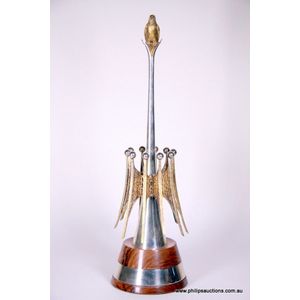Stuart Devlin Polly Parrot Centrepiece
You must be a subscriber, and be logged in to view price and dealer details.
Subscribe Now to view actual auction price for this item
When you subscribe, you have the option of setting the currency in which to display prices to $Au, $US, $NZ or Stg.
- Hallmarks - A mark stamped on articles of precious metals in Britain, since the 14th century, certifying their purity. It derives its name from the Guild Hall of the Goldsmiths' Company, who recieved its Charter in 1327 giving it the power to assay (test the purity) and mark articles of gold and silver.
The hallmark will consist of several marks, including the:
- silver standard mark, indicating the purity of the metal. Sterling silver is .925 pure silver.
- the city mark indicating the city in which it was assayed eg London, Birmingham, York etc.
- the date mark, usually a letter of the alphabet in a particular font and case,
- a duty mark, indicating whether duty had been paid to the crown, and only in use from 1784 to 1890
The piece may include an additional mark, the maker's mark, although not forming part of the hallmark, will be located in the vicinity of the hallmarks.
Sometimes silver plated items will bear faux hallmarks, often confusing those not familiar with silver markings. - Finial - An architectural decoration, found on the upper parts of of an object. On furniture they are usually found on pediments, canopies and shelf supports. On smaller ceramic or silver items, such as spoons, they may decorate the top of the item itself, or the lid or cover where they provide a useful handle for removal.
Finials have a variety of shapes and forms. They may be urn-shaped, baluster shaped round or spiral, but usually taper into an upper point. Many real life shapes may also be used as finials, such as pineapples, berries, pinecones, buds, lotus and acorns. Sometimes animals such as a lion are depicted, or fish and dolphins. - Devlin Stuart - Stuart Devlin was born in Geelong, Victoria, Australia and trained as an art teacher, after which he taught for 5 years and then studied gold and silversmithing, firstly in Melbourne and then at the Royal College of Art in London from 1958. He spent two years at Columbia University where he developed a career as a sculptor.
He returned to his teaching position in Melbourne in 1962 and was appointed Inspector of Art Schools.
In 1963 a competition was held to design the new Australian decimal coinage that was to be introduced in 1966. The new decimal coins were to replace the pre decimal coinage that had been in circulation since 1910. Six competitors vied for the honour of designing these new coins.
Devlin was announced the winner of the competition with designs that featured Australian native fauna on the new coins, with the 1c coin featuring the feather-tailed glider, the 2c a frilled neck dragon lizard, 5c a spiny echidna, the 10c a lyrebird, the 20c duck billed platypus and the 50c Australian Coat of Arms. The 1,c and 2c coins are no longer in circulation. A $1 coin also designed by Devlin and featuring the kangaroo, was introduced in 1984
In 1963 He became involved in the project to design Australia's decimal currency, and during this period he decided to relocate to London and establish himself as a silversmith.
He adapted his knowledge of sculpture into the designs he created for his showroom in Conduit Street in London's West End, which he occupied from 1979 to 1985. His output included limited editions which appealed to longer term collectors, such as Easter eggs and Christmas boxes.
His design skills have extended to furniture, jewellery, clocks, centrepieces, goblets, candelabra, bowls, and insignia.
Following his successful design on Australia's decimal currency, he has designed coins and medals for 36 countries.
He was Prime Warden of the Goldsmith's Company 1996-97 and in 1982 was appointed as goldsmith and jeweller to Queen Elizabeth II and in 1998 he was appointed a member of the Royal Mint Advisory Committee on the Designs of Coins, Medals, Seals and Decorations.
In 2000 he designed 25 coins for the Sydney Olympic Games including the Silver Kilo Olympic Masterpiece, the largest Olympic coin ever made, and the first to show all Olympic sports. He was also awarded an honorary doctorate from RMIT in 2000.
His work is displayed in the Victoria and Albert Museum as well as numerous Australian museums including Powerhouse Museum, Sydney, Museum Victoria and the National Gallery of Victoria.
He was awarded a Companion of the Order of St Michael and St George in the UK in 1980, and an Order of Australia in 1988. - Cartouche - An ornamental panel in the form of of a shield, oval or rectangular scroll with curling edges. It may be carved into the back of a chair or the top of a sideboard, or present on a piece of silver or jewellery, and contain the initials of the original owner, heraldic symbols, or some other inscription, such as the details of a presentation.
In ceramics the term defines the central area of a vase or similar with a decorative border in one of the shapes above, into which a decorative scene or figures have been painted.
This item has been included into following indexes:
Visually similar items

Sterling silver 950 marked decanter, 23 cm high

A silver epergne vase, the central trumpet vase surrounded by three smaller epergnes with scalloped mouths. Birmingham 1914 by Hukin & Heath Ltd. Height 27 cm

Five various crystal items, including two decanters; pair candlesticks; and vase. Height 30 cm (candlesticks)

A pair of French bronze candlesticks, early 20th century. the slender tapering sticks of Egyptian inspiration each with an engine turned dish above a lotus style capital, stiff leaf motifs to the base above a large spreading foot embellished with a frieze
